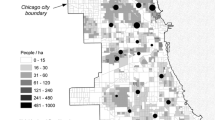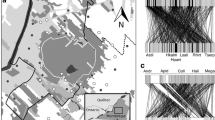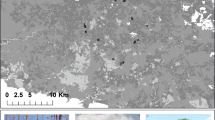Abstract
With their abundant floral resources, urban community gardens have the potential to play an important role in pollinator conservation. At the same time, the gardens themselves are dependent upon the pollination services provided by insects. Thus, understanding the variables that can increase bee richness or abundance in community gardens can contribute to both urban agriculture and pollinator conservation. Here we examine the impact of several environmental variables on bee abundance and diversity in urban community gardens in Sydney, Australia. We used hand netting and trap nests to sample bees in 27 community gardens ranging from inner city gardens with limited surrounding green space, to suburban gardens located next to national parks. We did not find strong support for an impact of any of our variables on bee species richness, abundance or diversity. We found high abundance of a recently introduced non-native bee: the African carder bee, Afranthidium repetitum (Schulz 1906). The abundance of African carder bees was negatively correlated with the amount of surrounding green space and positively correlated with native bee abundance/species richness. Our results highlight the seemingly rapid increase in African carder bee populations in inner city Sydney, and we call for more research into this bee’s potential environmental impacts. Our results also suggest that hard-to-change environmental factors such as garden size and distance to remnant forests may not have a strong influence on native bee diversity and abundance in highly urbanized area.

Similar content being viewed by others
References
Alves-dos-Santos I (2003) Trap-nesting bees and wasps on the university campus in São Paulo, southeastern Brazil (hymenoptera: Aculeata). J Kansas Entomol Soc 76:328–334
Baumann JM, Walker K, Threlfall C & Williams NS (2016) African Carder bee,'Afranthidium (Immanthidium) repetitum’(Hymenoptera: Megachilidae): A new exotic species for Victoria. Victorian Naturalist, The 133: 21.
Benson D, Howell J (1994) The natural vegetation of the Sydney 1: 100 000 map sheet. Cunninghamia 3:677–787
Burnham KP, Anderson DR (2002) Model selection and multimodel inference: a practical information-theoretic approach, 2nd edn. Springer, New York
Burnham KP, Anderson DR (2004) Multimodel inference understanding AIC and BIC in model selection. Sociol Methods Res 33:261–304
Dollin A, Batley M, Robinson M, Faulkner B (2000) Native bees of the Sydney region: a field guide. Australian Native Bee Research Centre Richmond, NSW
Gardiner MM, Burkman CE, Prajzner SP (2013) The value of urban vacant land to support arthropod biodiversity and ecosystem services. Environ Entomol 42:1123–1136
Gathmann A, Greiler H-J, Tscharntke T (1994) Trap-nesting bees and wasps colonizing set-aside fields: succession and body size, management by cutting and sowing. Oecologia 98:8–14
Grundel R, Jean RP, Frohnapple KJ, Glowacki GA, Scott PE, Pavlovic NB (2010) Floral and nesting resources, habitat structure, and fire influence bee distribution across an open-forest gradient. Ecol Appl 20:1678–1692
Guitart D, Pickering C, Byrne J (2012) Past results and future directions in urban community gardens research. Urban For Urban Green 11:364–373
Hennig E, Ghazoul J (2012) Pollinating animals in the urban environment. Urban Ecosystems 15:149–166
Hoehn P, Steffan-Dewenter I, Tscharntke T (2010) Relative contribution of agroforestry, rainforest and openland to local and regional bee diversity. Biodivers Conserv 19:2189–2200
Hope D et al (2003) Socioeconomics drive urban plant diversity. Proc Natl Acad Sci 100:8788–8792. doi:10.1073/pnas.1537557100
Klatt BK, Holzschuh A, Westphal C, Clough Y, Smit I, Pawelzik E, Tscharntke T (2014) Bee pollination improves crop quality, shelf life and commercial value. Proceedings of the Royal Society B: Biological Sciences 281 Vol. 281, No. 1775, p. 20132440
Klein AM, Vaissiere BE, Cane JH, Steffan-Dewenter I, Cunningham SA, Kremen C, Tscharntke T (2007) Importance of pollinators in changing landscapes for world crops. Proc R Soc B Biol Sci 274:303–313
Larson B, Kevan P, Inouye DW (2001) Flies and flowers: taxonomic diversity of anthophiles and pollinators. The Canadian Entomologist 133:439–465
Lowenstein D, Matteson K, Minor E (2015) Diversity of wild bees supports pollination services in an urbanized landscape. Oecologia:1–11
Matteson K, Langellotto G (2010) Determinates of inner city butterfly and bee species richness. Urban Ecosystems 13:333–347
Morato EF (2001) Efeitos da fragmentação florestal sobre vespas e abelhas solitárias na Amazônia Central. 11. Estratificação vertical Rev. Bras. Zool 18:737–747
Orford KA, Vaughan IP, Memmott J (2015) The forgotten flies: the importance of non-syrphid Diptera as pollinators. Proceedings of the Royal Society of London B: Biological Sciences 282 1805 (2015): 20142934.
Schulz WA (1906) Anthidium repetitum Spolia Hymenopterologica. Paderborn : Pape iii 356 pp. 1 pl [263] [nom. nov. for Anthidium integrum Friese, 1905]
Smith RM, Warren PH, Thompson K, Gaston KJ (2006) Urban domestic gardens (VI): environmental correlates of invertebrate species richness. Biodiversity & Conservation 15:2415–2438
Somanathan H, Borges R, Warrant E, Kelber A (2008) Visual ecology of Indian carpenter bees I: light intensities and flight activity. J Comp Physiol A 194:97–107
Steffan-Dewenter I (2002) Landscape context affects trap-nesting bees, wasps, and their natural enemies. Ecological Entomology 27:631–637
Stout JC, Morales CL (2009) Ecological impacts of invasive alien species on bees. Apidologie 40:388–409
Symonds M, Moussalli A (2011) A brief guide to model selection, multimodel inference and model averaging in behavioural ecology using Akaike’s information criterion. Behav Ecol Sociobiol 65:13–21
Threlfall CG, Walker K, Williams NSG, Hahs AK, Mata L, Stork N, Livesley SJ (2015) The conservation value of urban green space habitats for Australian native bee communities. Biol Conserv 187:240–248
Tonietto R, Fant J, Ascher J, Ellis K, Larkin D (2011) A comparison of bee communities of Chicago green roofs, parks and prairies. Landscape Urban Plann 103:102–108
Tscharntke T, Gathmann A, Steffan-Dewenter I (1998) Bioindication using trap-nesting bees and wasps and their natural enemies: community structure and interactions. J Appl Ecol 35:708–719
Vitiello, D. and M. Nairn. 2009. Community Gardening in Philadelphia: 2008 Harvest Report. 56 pp. Penn Planning and Urban Studies, University of Pennsylvania. Https://sites.google.com/site/harvestreportsite/philadelphia-report (accessed 30 March 2015)
Acknowledgments
We would like to thank Michael Batley from the Australian Museum for help identifying bees as well as providing ecological data. We also thank William Thompson, Sheridan Matthews and Alice Si for assistance in the field. The manuscript was greatly improved by comments from two anonymous referees. This project was funded by an Environmental Grant from the City of Sydney. We would like to thank Sophie Golding from the City of Sydney Council for help throughout the project. This work would not have been possible without the cooperation of our community gardeners who graciously allowed us to sample in their gardens.
Author information
Authors and Affiliations
Corresponding author
Appendix
Appendix
Rights and permissions
About this article
Cite this article
Makinson, J.C., Threlfall, C.G. & Latty, T. Bee-friendly community gardens: Impact of environmental variables on the richness and abundance of exotic and native bees. Urban Ecosyst 20, 463–476 (2017). https://doi.org/10.1007/s11252-016-0607-4
Published:
Issue Date:
DOI: https://doi.org/10.1007/s11252-016-0607-4




